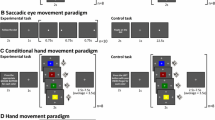Abstract
This study was aimed at testing the hypothesis about the development of lateralization of frontal motor control (FMC) as a source of preference of the right hand human in early ontogeny. The sample consisted of 108 children aged from 8 months (the initial stage of maturation of inhibitory control in reaching) to 11 months (the definitive stage). The main results showed the following: (1) at the population level, the preference of the right hand in the performance of tests that require a definite level of development of FMC appears only at the age of 11 months, i.e., synchronously with development of frontal inhibitory control of reaching; (2) the preference of the right hand is substantially stronger in 11-month-old children with a higher level of development of inhibitory motor control as compared to other children of the same age; (3) the preference of the right hand is most evident for those movements that require inhibitory control (i.e., controlled reaching). On the whole, the data obtained show that the appearance of a preference for the right hand in the second half-year of the life of an infant is caused by the development of cortical inhibitory control over motor acts (FMC), associated with the maturation of the frontal neocortex.
Similar content being viewed by others
REFERENCES
Yeo, R.A. and Gangestad, S.W., Developmental Origins of Variation in Human Hand Preference, Genetica, 1993, vol. 89, p. 281.
Kinsbourne, M. and Hiscock, M., Does Cerebral Hemispheres Develop?, Language Development and Neurological Theory, Segalowitz, S.J. and Gruber, F.A., Eds., New York: Academic, 1977, p. 54.
Bishop, D.V.M., Development of Handedness, Handedness and Developmental Disorders, London: Mac Keith, 1990, p. 53.
Butterworth, G.E. and Hopkins, B., Origins of Handedness in Human Infants, Develop. Med. and Child Neurology, 1993, vol. 35, no. 2, p. 177.
Bernstein, N.A., Biomekhanika i fiziologiya dvizhenii (Biomechanics and Physiology of Movements), Moscow- Voronezh: Institut prakticheskoi psikhologii, 1997.
Lennenberg, E.H., Biological Foundations of Language, New York: John Wiley, 1980.
Diamond, A., Developmental Time Course in Human Infants and Infant Monkeys, and the Neural Bases of Inhibitory Control in Reaching, The Development and Neural Bases of Higher Cognitive Functions, Ann. of the New York Acad. Sci., 1990, vol. 608, p. 394.
Diamond, A., Werker, J.F., and Lalonde, C., Toward Understanding Commonalities in the Development of Object Search, Detour Navigation, Categorization, and Speech Perception, Human Behavior and the Developing Brain, Dawson, G. and Fischer, K.W., Eds., New York: Guilford, 1994, p. 380.
Bayley, N., Bayley Scales of Infant Development, Berkeley: Univ. of California, 1969.
Annet, M., Annotation: Laterality and Cerebral Dominance, Childhood Psychol. and Psychiatry, 1991, vol. 32, p. 219.
Bishop, D.V.M., Definition and Measurement of Handedness, Handedness and Developmental Disorders, London: Mac Keith, 1990, p. 69.
Harris, L.J., Laterality of Function in the Infant: Historical and Contemporary Trends in Theory and Research, Manual Specialization and the Developing Brain, Young, G., Segalowitz, S.J., Corter, C., and Tregub, S., Eds., New York: Academic, 1982, p. 177.
Shinn, M.W., Notes on the Development of a Child, Berkeley: Univ. of California Press, 1984.
De Shonen, S. and Mathivet, E., First Come, First Served: About the Development of Hemispheric Specialization in Face Recognition during Infancy, Cahiers de Psychologie Cognitive European Bulletin of Cognitive Psychology, 1989, vol. 9, no. 1, p. 3.
Emde, R.N., Gaensbower, T.Y., and Harmon, R.J., Emotional Expression in Infancy. A Biobehavioral Study, Psychological Issues, New York: Intern. Univ. Press, 1976, vol. 10, no. 1, p. 1.
Hershkowitz, N., Kagan, J., and Zilles, K., Neurobiological Bases of Behavioral Development in the First Year, Neuropediatrics, 1997, vol. 28, p. 296.
Bates, E., cited by Bishop, D.V.M., Handedness and Developmental Disorders, London: Mac Keith, 1990.
Hepper, P.G., Shahidullah, S., and White, R., Origin of Fetal Handedness, Nature, 1990, vol. 347, p. 431.
Cioni, G. and Pellegrinetti, G., Lateralization of Sensory and Motor Functions in Human Neonates, Percept. and Motor Skills, 1982, vol. 54, p. 1151.
Gesell, A. and Ames, L.B., The Development of Handedness, J. Genetic Psychol., 1974, vol. 70, p. 155.
Rader, N. and Stern, J.D., Visually Elicited Reaching in Neonates, Child Devel., 1982, vol. 52, p. 1004.
Tucker, D., Developing Emotions and Cortical Networks, Developmental Behavioral Neuroscience, Gunnar, M.R. and Nelson, Ch.A., Eds., Hillsdale, NJ: Lowrence Erlbaum Ass., 1992, p. 75.
Author information
Authors and Affiliations
Rights and permissions
About this article
Cite this article
Stroganova, T.A., Posikera, I.N., Pushina, N.P. et al. Lateralization of Motor Functions in Early Human Ontogeny. Human Physiology 29, 40–48 (2003). https://doi.org/10.1023/A:1022096301176
Issue Date:
DOI: https://doi.org/10.1023/A:1022096301176




